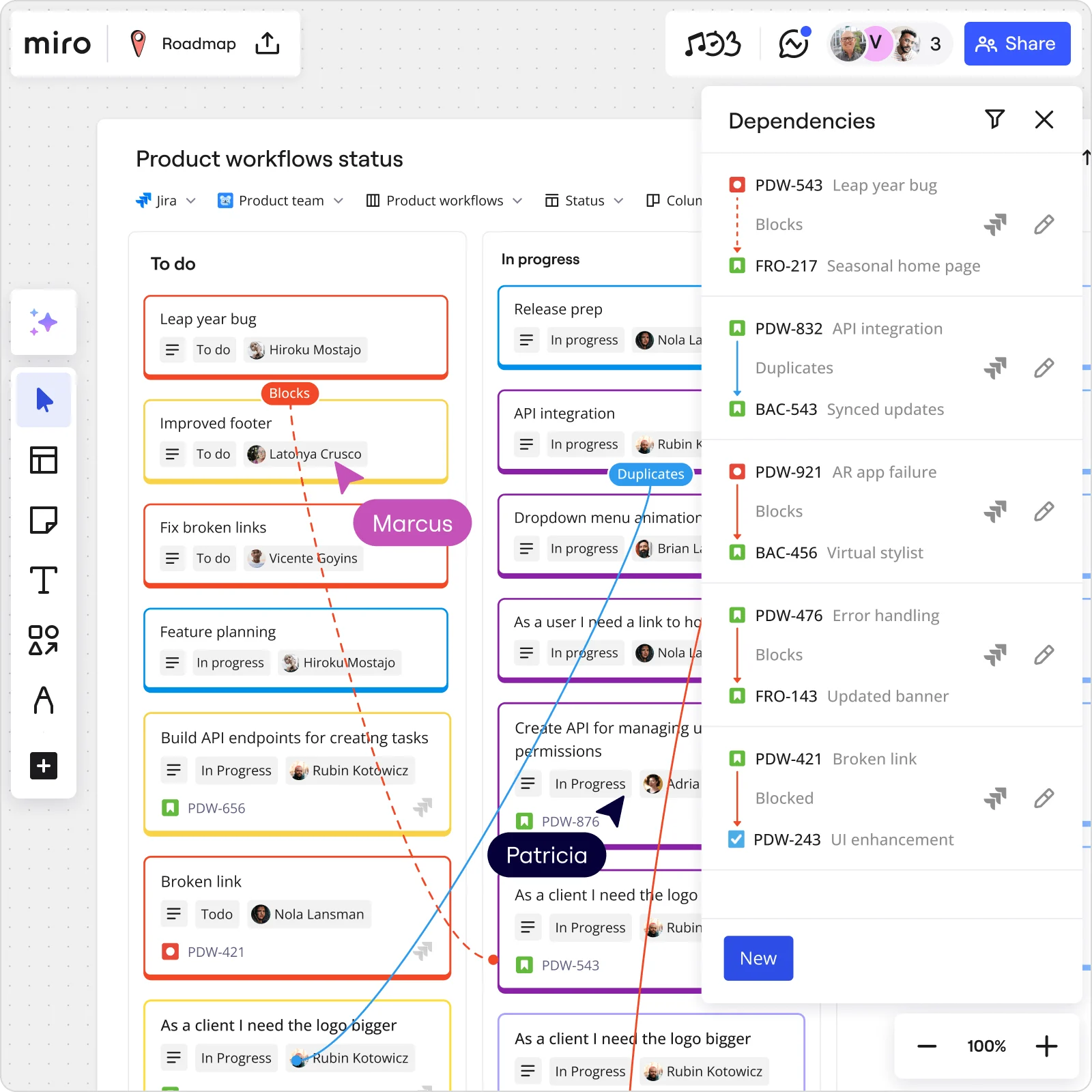
What is Scrum@Scale? Boost team productivity and agility

Summary
In this guide, you will learn:
- What Scrum at Scale is: extending Scrum principles across an organization.
- Key components: Scrum Master Cycle, Product Owner Cycle, Executive MetaScrum, EAT.
- Scrum Master Cycle: team efficiency, velocity, impediment removal.
- Product Owner Cycle: prioritization, alignment with organizational goals.
- Leadership role: Executive MetaScrum and EAT in vision and systemic issues.
- How Miro supports Scrum at Scale: visualization, collaboration, workflow tracking for distributed teams.
Try Miro now
Join thousands of teams using Miro to do their best work yet.
Scrum at Scale, often referred to as Scrum@Scale, is a framework that enables organizations to apply the principles of Scrum across multiple teams while maintaining agility and efficiency. By scaling Scrum, companies can enhance team collaboration, streamline workflows, and deliver value faster. This guide dives deep into what is Scrum at Scale, how it compares to other frameworks like SAFe, and practical tips for implementation.
What is Scrum at Scale?
Scrum at Scale is a framework designed to expand the core principles of Scrum across an entire organization. It emphasizes flexibility, simplicity, and the ability to scale without sacrificing the agility of individual teams. Unlike rigid methodologies, Scrum at Scale adapts to the unique needs of a business while maintaining alignment across teams and departments. The Scrum at Scale framework is particularly effective for organizations seeking to improve coordination, reduce bottlenecks, and accelerate delivery.
Scrum at Scale vs. SAFe
While both Scrum at Scale and the Scaled Agile Framework (SAFe) aim to scale Agile practices, they differ in approach and structure:
- Scrum at Scale prioritizes simplicity and flexibility, allowing organizations to customize the framework to their needs. It focuses on maintaining the autonomy of individual teams while ensuring coordination across the organization.
- SAFe, on the other hand, provides a more prescriptive approach with predefined roles, artifacts, and ceremonies. It’s ideal for enterprises looking for a detailed, structured framework.
Organizations often choose Scrum at Scale vs. SAFe based on their size, goals and need for flexibility.

Key components of the Scrum at Scale framework
The Scrum at Scale framework consists of several critical components:
Scrum Master Cycle
This ensures that teams operate efficiently, focusing on improving velocity, removing impediments, and fostering collaboration between teams.
Product Owner Cycle
This manages prioritization across multiple teams, ensuring alignment with organizational goals and customer needs.
Executive MetaScrum
This leadership-level meeting aligns the overall vision and ensures strategic priorities are communicated across teams.
Executive Action Team (EAT)
This team supports the Scrum Master Cycle by addressing systemic impediments and ensuring the smooth functioning of the organization’s Scrum processes.
Benefits of implementing Scrum at Scale
Adopting Scrum at Scale brings several organizational advantages:
Increased productivity
By streamlining workflows and ensuring effective communication between teams, organizations can achieve higher efficiency and faster delivery times.
Improved alignment
Scrum at Scale helps synchronize team objectives with broader organizational goals, ensuring that everyone moves in the same direction.
Greater adaptability
The framework’s flexibility allows teams to respond quickly to market changes, shifting priorities, or unexpected challenges.
Enhanced transparency
Frequent reviews and open communication foster a culture of accountability and visibility across all levels of the organization.

How to implement Scrum at Scale
Implementing Scrum at Scale requires careful planning and execution. Here’s a step-by-step guide:
Step 1: Establish executive sponsorship
Secure buy-in from leadership to ensure alignment with organizational goals and adequate resource allocation.
Step 2: Identify the initial teams
Begin with a few pilot teams to test and refine the implementation process before scaling further.
Step 3: Define Scrum Master and Product Owner cycles
Ensure that roles and responsibilities are clearly defined for coordination across teams and departments.
Step 4: Train teams and leaders
Provide comprehensive training on Scrum at Scale principles, roles, and ceremonies to set the foundation for success.
Step 5: Monitor and adapt
Regularly review progress, collect feedback, and make adjustments to address challenges and optimize the process.
Challenges in scaling Scrum
Scaling Scrum can present some challenges. Here’s how to address them:
Resistance to change
Teams may resist new processes. Address this with effective communication, training, and leadership support.
Maintaining agility
As organizations grow, maintaining agility can be difficult. Focus on preserving the autonomy of individual teams while aligning them with the broader strategy.
Coordination across teams
Effective communication becomes more challenging with more teams. Use tools like Miro to visualize workflows and keep workflows smooth.

Case studies and success stories
Let's look at a few real-world examples of Scrum@Scale:
Example 1: A global tech company
A global software firm implemented Scrum at Scale to manage its product portfolio across 20 teams. By aligning team objectives with organizational goals, the company reduced delivery times by 25%.
Example 2: A financial services provider
A financial organization adopted Scrum at Scale framework to improve collaboration between teams in different regions. The result was a 15% increase in customer satisfaction scores due to faster feature rollouts.
Example 3: A healthcare startup
A healthcare startup used Scrum at Scale to manage rapid growth. By scaling Agile practices, the company streamlined its development cycles and brought new products to market 30% faster.
Scale at Scrum with Miro
Miro’s innovation workspace is the perfect tool for teams implementing Scrum at Scale. With Miro, you can visualize workflows, track progress, and collaborate across distributed teams in real time. Whether you’re learning how to implement Scrum at Scale or refining your processes, Miro makes it easy to stay aligned.
Start scaling your Agile practices effectively. Sign up for Miro to get started.
Author: Miro Team
Last update: October 1, 2025